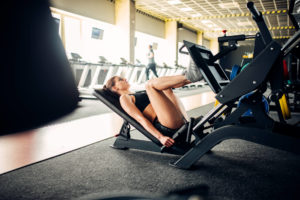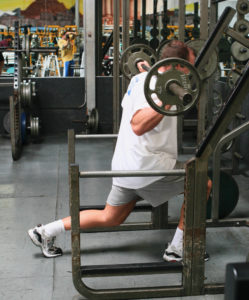
How to work your legs when your lower back is holding you back
By Strength Sensei CP
For the past half-century, mainstream magazines articles addressing lower back pain often contained a statement that 80 percent of Americans will suffer from lower back pain and 20 percent are currently in pain. In recent years, the focus has been more on the increasing number of Americans needing surgery to resume a normal life. Estimates vary, but the number of American’s going under the knife each year for back pain is approaching half a million! If you belong to one of these statistical categories, you know compromises will have to be made on leg day. Starting with squats.
Yes, the squat is the King of Lifts, but you shouldn’t be doing full squats if your lower back is hurting. And no, you shouldn’t be doing quarter squats either. Russian sports scientist Yuri Verkhoshansky experimented with quarter squats to duplicate the stresses on the legs in track and field events, such as the triple jump. He found that during the takeoff for a triple jump, the force could reach up to 660 pounds! Although his athletes could lift extremely heavy loads in quarter squats, the result was lower back pain. This dilemma inspired him to create depth jump training, a rebounding jump that involves creating and releasing the kinetic energy in the tendons and other types of connective tissues. Eventually, Verkhoshansky earned the nickname “The Father of Plyometrics.”
If fat loss is your primary goal, should you consider taking aerobic classes until your back is back to normal? Probably not. In the prime years of Muscle Media 2000, I wrote about why you often see so many lean women (and sometimes men) in aerobic classes. The answer is not that these classes are phenomenal fat burners and joint healthy, but those students who developed lower back pain or other orthopedic issues quickly drop out of these classes.
Next, consider that if you have back pain, deadlifts may not be out of the question. Sumo deadlifts and hex bar deadlifts place less stress on the spine than conventional straight-bar deadlifts. Further, often the best way to resolve your condition is with “hip dominant” exercises such as back extensions (horizontal and incline) and (a favorite of powerlifting guru Louie Simmons) reverse hypers. These exercises place minimal compressive forces on the spine and provide traction on the spine, which may help promote healing.
Among the go-to “quad-dominant” exercises to work the legs with minimal stress on the lower back leg presses, step-ups, lunges, split squats, and leg extensions.
 If squats are out of the question, they are many alternative exercises to squats that can keep your legs growing strong.(Miloš Šarčev photo)
If squats are out of the question, they are many alternative exercises to squats that can keep your legs growing strong.(Miloš Šarčev photo)
Leg presses can be performed vertically, horizontally, and angled. Leg presses emphasize the vastus lateralis, the largest quadriceps muscle that sweeps the outside of the leg. With the leg press, the trunk is stabilized, so often those with back pain can perform this exercise heavy without aggravating their condition. The key is not to lower the weight so low that your hips roll under. And although leg extensions are certainly back-friendly, they place high shearing forces on the knees and may not be worth the risk in the long term.
Although machines are the obvious solution to circumventing back pain, lunges, split squats, and step-ups are a better alternative. In addition, these exercises have a better transfer to athletic fitness training and can be used for rehabilitation. On this last point, for my clients with knee issues such as tendinitis, I often use a progression of the Poliquin step-up and Petersen step-up to resolve this condition so they can squat. After step-ups, I usually progress to split squats, lunges, and finally, squats. One more point on this subject.
After performing a structural balance assessment on a new client, I often have them perform step-ups or split squats to correct structural imbalances before focusing on squats. Structural balance not only refers to the strength ratios between opposing muscles (agonist and antagonist) but between limbs. So, for example, the strength of the muscles on the right leg should be nearly equal to the strength of muscles on the left leg. In the long term, this approach often produces better results in increasing squatting strength and helping to prevent injury.
If lower back pain keeps you away from the squat rack, consider that there are other alternatives to leg extensions. First, strong with these alternatives, then when you’re ready to squat again, get stronger!
